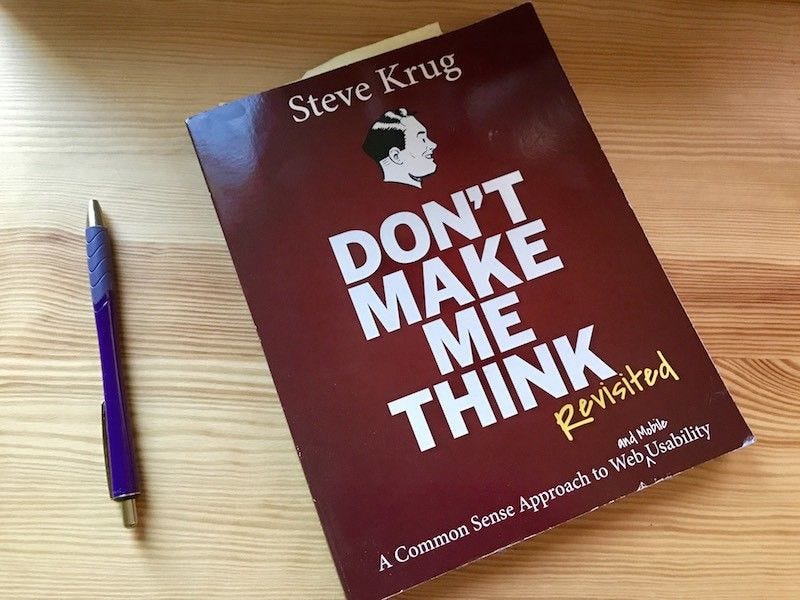Issue 11: How not to run into the modals' festival
New plugins and widgets for Figma; Manager for storing design systems; Free design system of 800+ components and so much more!

Hello, dear readers! 👋
In this issue, among other things:
Overview of basic design principles
How to overcome impostor syndrome
Summary of the Apple Human Interface report from 1997
Cheat sheet on how to replace modal windows
Mobile UX Design Manual from Nielsen Norman Group
Free design system of 800+ components
Manager for storing design systems
New plugins and widgets for Figma
Quotes from "Don't make me think" book by Steve Krug
Enjoy reading!
📚 Book quotes
For this issue, I read Steve Krug's book "Don't make me think: A Common Sense Approach to Web Usability". Here are the most interesting quotes from it.
It doesn’t matter how many times I have to click, as long as each click is a mindless, unambiguous choice.
If there's one thing you learn by working on a lot of different Web sites, it's that almost any design idea--no matter how appallingly bad--can be made usable in the right circumstances, with enough effort.
Get rid of half the words on each page, then get rid of half of what’s left.
Your primary role should be to share what you know, not to tell people how things should be done.
Your objective should always be to eliminate instructions entirely by making everything self-explanatory, or as close to it as possible. When instructions are absolutely necessary, cut them back to a bare minimum.
Designers love subtle cues, because subtlety is one of the traits of sophisticated design. But Web users are generally in such a hurry that they routinely miss subtle cues.
If you want a great site, you’ve got to test. After you’ve worked on a site for even a few weeks, you can’t see it freshly anymore. You know too much. The only way to find out if it really works is to test it.
And not just the right thing; it’s profoundly the right thing to do, because the one argument for accessibility that doesn’t get made nearly often enough is how extraordinarily better it makes some people’s lives. How many opportunities do we have to dramatically improve people’s lives just by doing our job a little better?
Happy talk must die
If you can’t make something self-evident, you at least need to make it self-explanatory.
Faced with the prospect of following a convention, there’s a great temptation for designers to try reinventing the wheel instead, largely because they feel (not incorrectly) that they’ve been hired to do something new and different, not the same old thing. Not to mention the fact that praise from peers, awards, and high-profile job offers are rarely based on criteria like “best use of conventions.” Occasionally, time spent reinventing the wheel results in a revolutionary new rolling device. But usually it just amounts to time spent reinventing the wheel.
🗞 News and articles
Origins of the Apple human interface
Riccardo Mori prepared a long summary of the report that Larry Tesler and Chris Espinosa read on October 28, 1997 at the California Museum of Computer History. He also added his own comments and clarifications to help understand the context of that time.
With the help of the synopsis, Riccardo wanted to show how much work was required at the time when the Apple Lisa computer and such breakthrough programs as LisaGraph, LisaList and LisaWrite were created.
Recording of the original 1997 performance on Youtube.
Design Principles: why a design works
An excellent article by Miklos Philips, in which he analyzes the fundamental design principles, and also explains why it is important to observe them in order not to cause cognitive tension in the viewer. He examines such concepts as visual hierarchy, balance, contrast, symmetry, scale and proportions, the rule of thirds, unity and many others.
Design Principles: why a design works
Overcoming Imposter Syndrome By Developing Your Own Guiding Principles
Louis Uriah tells how a novice designer can overcome the impostor syndrome, feel more confident in the labor market and how to present his work more confidently.
Thoughts from the article:
Most likely, you will never be satisfied with the results of the project and this is normal. This happens to everyone
The more experience you have, the more self—doubt you have, and not the other way around
Do not overestimate your expectations from colleagues, so as not to get upset in the future. People can make both right and wrong decisions
Read more books. It is important to read not what someone thinks about you, but what you consider to be the truth
Try to briefly formulate what you like about your work and focus on this positive principle. For example, "I like to create something new"
If you are creating something visual, then try sharing your work with the community to find the strengths and weaknesses of your work
If you feel best in the morning, then try to schedule a project presentation for the morning. This way you can reduce stress
If it is difficult for you to remember all the details of the project that you will present, then you can distribute the materials to the audience or share a link to your presentation
Overcoming Imposter Syndrome By Developing Your Own Guiding Principles — Smashing Magazine
⚡️ Briefly
Nielsen Norman Group has published a tutorial on mobile UX design. Inside is a collection of articles and video tutorials that are sorted for study in the correct order.







